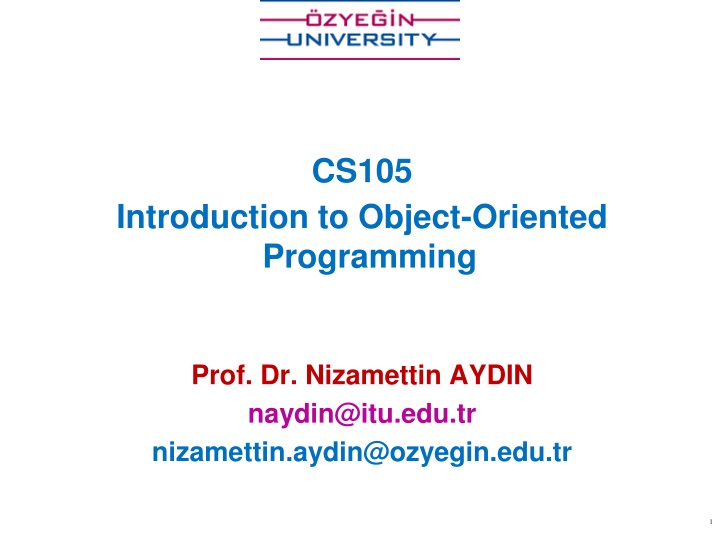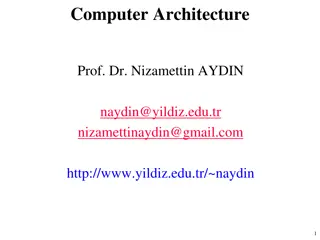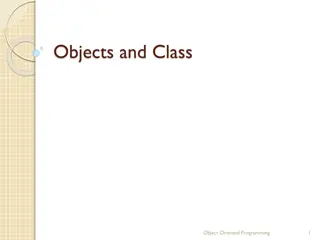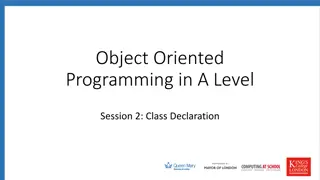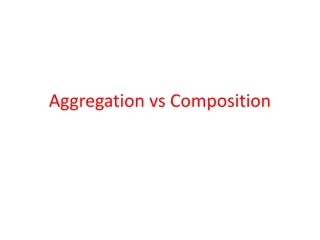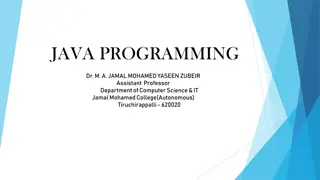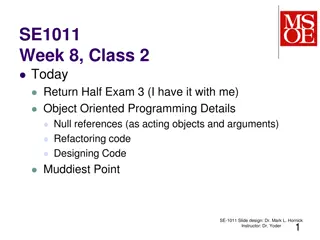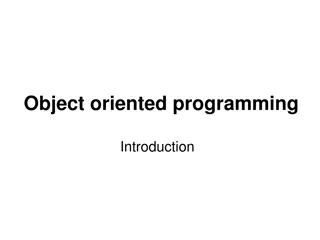Object-Oriented Programming with Prof. Dr. Nizamettin AYDIN
This content delves into object-oriented programming concepts with a focus on algorithms, methods, and structured approaches. It discusses the importance of removing redundancy in algorithms and provides examples to illustrate the concepts effectively.
Download Presentation

Please find below an Image/Link to download the presentation.
The content on the website is provided AS IS for your information and personal use only. It may not be sold, licensed, or shared on other websites without obtaining consent from the author.If you encounter any issues during the download, it is possible that the publisher has removed the file from their server.
You are allowed to download the files provided on this website for personal or commercial use, subject to the condition that they are used lawfully. All files are the property of their respective owners.
The content on the website is provided AS IS for your information and personal use only. It may not be sold, licensed, or shared on other websites without obtaining consent from the author.
E N D
Presentation Transcript
CS105 Introduction to Object-Oriented Programming Prof. Dr. Nizamettin AYDIN naydin@itu.edu.tr nizamettin.aydin@ozyegin.edu.tr 1
Method 2
Outline Algorithms Removing redundancy Methods Using methods Design of an algorithm Declaring a method Calling a method Program with a method Methods calling methods Control flow When to use method 3
ALGORITHMS Algorithm: A list of steps for solving a problem. Example algorithm: "Bake sugar cookies" Mix the dry ingredients. Cream the butter and sugar. Beat in the eggs. Stir in the dry ingredients. Set the oven temperature. Set the timer. Place the cookies into the oven. Allow the cookies to bake. Spread frosting and sprinkles onto the cookies. ... 4
PROBLEMS WITH ALGORITHMS lack of structure: Many tiny steps; tough to remember. redundancy: Consider making a double batch... Mix the dry ingredients. Cream the butter and sugar. Beat in the eggs. Stir in the dry ingredients. Set the oven temperature. Set the timer. Place the first batch of cookies into the oven. Allow the cookies to bake. Set the timer. Place the second batch of cookies into the oven. Allow the cookies to bake. Mix ingredients for frosting. ... 5
STRUCTURED ALGORITHMS structured algorithm: Split into coherent tasks. 1. Make the cookie batter. Mix the dry ingredients. Cream the butter and sugar. Beat in the eggs. Stir in the dry ingredients. 2. Bake the cookies. Set the oven temperature. Set the timer. Place the cookies into the oven. Allow the cookies to bake. 3. Decorate the cookies. Mix the ingredients for the frosting. Spread frosting and sprinkles onto the cookies. 6
REMOVING REDUNDANCY A well-structured algorithm can describe repeated tasks with less redundancy. 1. Make the cookie batter. Mix the dry ingredients. ... 2. A. Bake the cookies (first batch). Set the oven temperature. Set the timer. ... B. Bake the cookies (second batch). 3. Decorate the cookies. ... 7
A PROGRAM WITH REDUNDANCY public class BakeCookies { public static void main(String[] args) { System.out.println("Mix the dry ingredients."); System.out.println("Cream the butter and sugar."); System.out.println("Beat in the eggs."); System.out.println("Stir in the dry ingredients."); System.out.println("Set the oven temperature."); System.out.println("Set the timer."); System.out.println("Place a batch of cookies into the oven."); System.out.println("Allow the cookies to bake."); System.out.println("Set the oven temperature."); System.out.println("Set the timer."); System.out.println("Place a batch of cookies into the oven."); System.out.println("Allow the cookies to bake."); System.out.println("Mix ingredients for frosting."); System.out.println("Spread frosting and sprinkles."); } } 8
METHODS Methods have their origins in the mathematical concept of a function. A method is a function that belongs to a class. A method performs some useful behaviour made up using code. A method can have any number of inputs, and either one or zero output. A method with zero outputs is called a void method. A black box model with input(s) and an output A maths function of the form y = f(x) 9
METHODS method: A named group of statements. denotes the structure of a program eliminates redundancy by code reuse procedural decomposition: dividing a problem into methods Writing a method is like adding a new command to Java. 10
METHODS The maths way is helpful helps us understand the origins of the syntax for calling methods. The black box model is helpful reminds us of the procedural programming paradigm, process inside the method is encapsulated within that method. All methods in Java must belong to a class they cannot exist in isolation. can be defined anywhere inside their host class. A method definition takes the general form: <access-modifier> <return-type> method-name(<formal-parameters>) { // Body of method <return-statement-if-not-void> } 11
METHODS <Access-modifier>: public or private depending on whether the method is intended to be invokable by other classes, or only by methods inside the class in which it was defined. Other access modifiers also exist. If not specified, the access modifier is assumed to be public. <return-type>: the Java type of any output generated by this method. If the method does not produce any returned output, the return type is void. A return type must always be specified. The method-name: any valid name, by convention starting with a lower-case letter. The <formal-parameters>: a list of zero or more parameters that the method will take as inputs to do the job that is designed to perform. If there are no inputs, the set of empty round brackets must still be included to denote that this is a method definition. return statement: if the method produces a value to be returned, i.e. it is not void, then the return statement is used to signify the value that is returned. Executing a return statement at any point during a method invocation causes the method to finish. 12
METHODS An example method definition that takes two formal parameters and produces an output: public int addTwoNumbers(int a, int b) { int c; c = a + b; return c; } To use this method, we would use some calling code (within another method) like this: int d; d = addTwoNumbers(3,4); System.out.println(d); In this example, we invoke the method addTwoNumbers() with two actual parameters, 3 and 4 in this case. 13
METHODS another example of a method that takes two parameters, determines which is larger and displays an appropriate message on the console: public void showLarger(int a, int b){ if (a > b){ System.out.println("a is larger"); } else if (b > a){ System.out.println("b is larger"); } else { System.out.println("a is equal to b"); } } Note that as this method is void, there is no return keyword 14
USING METHODS 1. Design the algorithm. Look at the structure, and which commands are repeated. Decide what are the important overall tasks. 2. Declare (write down) the methods. Arrange statements into groups and give each group a name. 3. Call (run) the methods. The program's main method executes the other methods to perform the overall task. 15
DESIGN OF AN ALGORITHM // This program displays a delicious recipe for baking cookies. public class BakeCookies2 { public static void main(String[] args) { // Step 1: Make the cake batter. System.out.println("Mix the dry ingredients."); System.out.println("Cream the butter and sugar."); System.out.println("Beat in the eggs."); System.out.println("Stir in the dry ingredients."); // Step 2a: Bake cookies (first batch). System.out.println("Set the oven temperature."); System.out.println("Set the timer."); System.out.println("Place a batch of cookies into the oven."); System.out.println("Allow the cookies to bake."); 16
DESIGN OF AN ALGORITHM // Step 2b: Bake cookies (second batch). System.out.println("Set the oven temperature."); System.out.println("Set the timer."); System.out.println("Place a batch of cookies into the oven."); System.out.println("Allow the cookies to bake."); // Step 3: Decorate the cookies. System.out.println("Mix ingredients for frosting."); System.out.println("Spread frosting and sprinkles."); } } 17
DECLARING A METHOD Gives your method a name so it can be executed Syntax: public static void name() { statement; statement; ... statement; } Example: public static void printWarning() { System.out.println("This product causes cancer"); System.out.println("in lab rats and humans."); } 18
CALLING A METHOD Executes the method s code Syntax: name(); You can call the same method many times if you like. Example: printWarning(); Output: This product causes cancer in lab rats and humans. 19
PROGRAM WITH A METHOD public class RapLyrics { public static void main(String[] args) { rap(); // Calling (running) the rap method System.out.println(); rap(); // Calling the rap method again } // This method prints the lyrics to my favorite song. public static void rap() { System.out.println(" stisnalar kaideyi bozmaz, "); System.out.println("Kuru yan nda ya telas yapmaz. "); } } Output: Istisnalar kaideyi bozmaz, Kuru yan nda yas telas yapmaz. Istisnalar kaideyi bozmaz, Kuru yan nda yas telas yapmaz. 20
FINAL COOKIE PROGRAM // This program displays a delicious recipe for baking cookies. public class BakeCookies3 { public static void main(String[] args) { makeBatter(); bake(); // 1st batch bake(); // 2nd batch decorate(); } // Step 1: Make the cake batter. public static void makeBatter() { System.out.println("Mix the dry ingredients."); System.out.println("Cream the butter and sugar."); System.out.println("Beat in the eggs."); System.out.println("Stir in the dry ingredients."); } 21
FINAL COOKIE PROGRAM // Step 2: Bake a batch of cookies. public static void bake() { System.out.println("Set the oven temperature."); System.out.println("Set the timer."); System.out.println("Place a batch of cookies into the oven."); System.out.println("Allow the cookies to bake."); } // Step 3: Decorate the cookies. public static void decorate() { System.out.println("Mix ingredients for frosting."); System.out.println("Spread frosting and sprinkles."); } } 22
FINAL COOKIE PROGRAM // This program displays a delicious recipe for baking cookies. public class BakeCookies3 { public static void main(String[] args) { makeBatter(); bake(); // 1st batch bake(); // 2nd batch decorate(); } // Step 1: Make the cake batter. public static void makeBatter() { System.out.println("Mix the dry ingredients."); System.out.println("Cream the butter and sugar."); System.out.println("Beat in the eggs."); System.out.println("Stir in the dry ingredients."); } // Step 2: Bake a batch of cookies. public static void bake() { System.out.println("Set the oven temperature."); System.out.println("Set the timer."); System.out.println("Place a batch of cookies into the oven."); System.out.println("Allow the cookies to bake."); } // Step 3: Decorate the cookies. public static void decorate() { System.out.println("Mix ingredients for frosting."); System.out.println("Spread frosting and sprinkles."); } } 23
METHODS CALLING METHODS public class MethodsExample { public static void main(String[] args) { message1(); message2(); System.out.println("Done with main."); } public static void message1() { System.out.println("This is message1."); } public static void message2() { System.out.println("This is message2."); message1(); System.out.println("Done with message2."); } } Output: This is message1. This is message2. This is message1. Done with message2. Done with main. 24
CONTROL FLOW When a method is called, the program s execution jumps into that method, executing its statements, then jumps back to the point where the method was called. public class MethodsExample { public static void main(String[] args) { message1(); public static void message1() { System.out.println("This is message1."); } public static void message2() { System.out.println("This is message2."); message1(); message2(); System.out.println("Done with message2."); } System.out.println("Done with main."); } ... public static void message1() { System.out.println("This is message1."); } } 25
WHEN TO USE METHODS Place statements into a method if: The statements are related structurally, and/or The statements are repeated. You should not create methods for: An individual println statement. Only blank lines. (Put blank printlns in main.) Unrelated or weakly related statements. (Consider splitting them into two smaller methods.) 26
